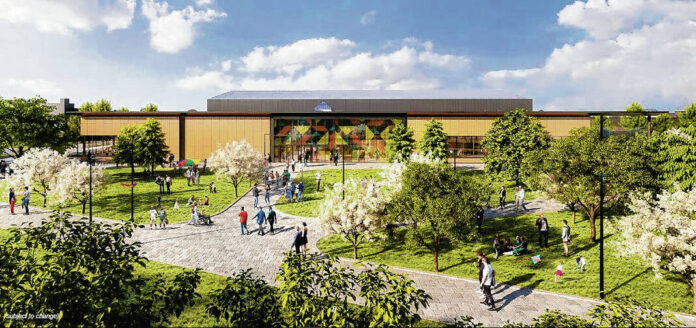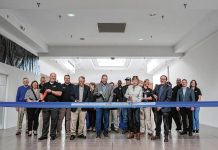Columbus Parks and Recreation board members have approved a 2022-2026 master plan for the city department.
This strategic master plan is 161 pages long — 257 with appendices — and includes information on the planning process, public feedback, facility and amenity needs, local demographics and a strategic action plan so that staff can track the plan’s implementation.
The document is available at columbusparksandrec.com/master-plans/. Copies can also be viewed at Donner Center.
“The purpose of the plan is to serve as a usable ‘blueprint’ to the staff, park board and the city council in preparing a needs assessment and action plan for the growing and extremely diverse population that calls Columbus home,” the master plan states. “This document is intended to be a dynamic and forward-thinking one to strengthen existing programs, facilities, and amenities to serve as a road map for the future.”
Prior to parks board’s vote to approve the plan, PROS Consulting gave a presentation on its findings from the planning process. The firm has been involved in the plan’s creation. ETC Institute, a statistically-valid survey firm, has also contributed to the project.
PROS Principal Neelay Bhatt said its survey of local residents indicated that some of their top priorities for facilities and amenities — both in terms of high interest and/or unmet need — were indoor walking and jogging tracks, restrooms, multi-use paved trails and and an indoor aquatic enter. On the programming side, top priorities included adult fitness and wellness programs, farmers’ markets and community special events.
Neighborhood parks, splash pads, indoor recreation spaces and pickleball courts are also areas of need, he said. He also noted that it’s important to focus on both long-term and immediate priorities.
“Nexus is truly a transformational project, and it’s one of the benchmarks they’re using around the country, but that’s what we want the entire system to be, right?” said Bhatt. “Because you’ve got some absolute crown jewels, and then you’ve got stuff like Donner that really need to be taken care of now. And so this approach, as you think of this system-wide plan, the best way to talk about this is it’s a roadmap for the future.”
Community members indicated that the department should focus on maintaining existing facilities, not just building new ones, he said.
PROS also consulted with parks staff about their values and ideas for the future. From this, five major goals emerged:Developing a marketing and branding strategy centered on “telling the story” of the department.
Master planning Donner Park and Pool to provide an updated aquatics facility.
Seeking additional funding to reinvest in existing and new parks and facilities.
Seeking accreditation and another National Gold Medal Award from the Commission for Accreditation of Park and Recreation agencies.
Successfully developing NexusPark.
NexusPark — the city of Columbus and Columbus Regional Hospital’s joint effort to redevelop FairOaks Mall into a health, wellness and recreation center — was mentioned in the master plan and its appendices. While the development is expected to create opportunities for the department, there are also challenges that come with its operation.
The campus is expected to include an indoor fieldhouse, Columbus Parks administrative and recreational spaces, restaurant and retail areas, and CRH facilities. The NexusPark site also states that “outdoor community park and gathering spaces” are planned, and Dunham’s is expected to remain on-site under its current lease.
“Repurposing this property keeps it from becoming an attractive nuisance and a dilapidated eyesore to the residents while creating a gathering space for resident programs and regional draw with positive economic impacts,” the parks master plan stated.
For instance, sports tournaments at the planned fieldhouse could bring in significant revenue and also benefit the hospitality industry.
However, the document noted that a strong brand identity, proper staffing, flexible design, funding and a plan for inflation will be needed to support NexusPark’s success. Staffing, in particular, was highlighted in the plan’s conclusion as an ongoing issue for the department.
“The community’s needs have outpaced the current staff offerings and resources and with the addition of NexusPark this gap can further widen,” the master plan states. “Thus, it is critical that as the city looks to invest in updating what it has (e.g., Donner Park and Pool) and building new offerings (e.g., NexusPark) that it continues to have a proportionate increase in staffing and resources as well.”
Based on the fieldhouse design for NexusPark, the following positions were recommended to support operations: manager, guest services supervisor, maintenance supervisor, maintenance team leader, cleaning crew, maintenance labor and guest services/recreation assistant(s). Consultants estimated possible salary and wage ranges for each position and also recommended that key positions at NexusPark will need to be brought online at least a year in advance to prepare the department for opening day.
There is also potential competition from other communities, as sports facilities are also being developed in Auburn and Lebanon, as well as Paducah and Frankfort, Kentucky. This could lead to the market becoming oversaturated, with venues attracting participants from each other and causing a decline in participation.
Therefore, it’s important for Columbus create a strong niche that can attract a variety of both state and regional users, the consultants said.
The parks master plan also includes public feedback on NexusPark, such as findings from the statistically valid survey. According to the survey, households indicated that the features they’d be most likely to use at NexusPark, if included in the facility, were an indoor walking/jogging track, a weight room/cardiovascular equipment area, food service, aerobics/fitness/gymnastics space, and group fitness classes.
When asked how NexusPark operations should be funded, respondents replied as follows:25.8% said that user fees should pay for the majority of costs, with new taxes paying the remainder.
23.4% said that new general city taxes should pay for the majority of costs, with user fees making up the remainder.
18.6% did not have an opinion.
16.2% said that 100% of operating costs should be paid through user fees.
16.0% said that 100% of operating costs should be paid through existing city taxes.
Parks Director Mark Jones said that the department was able to get a lot accomplished with its previous master plan. “This is something we feel even more strongly about, this master plan, so anxious to see what we can do here in the future,” he said.





